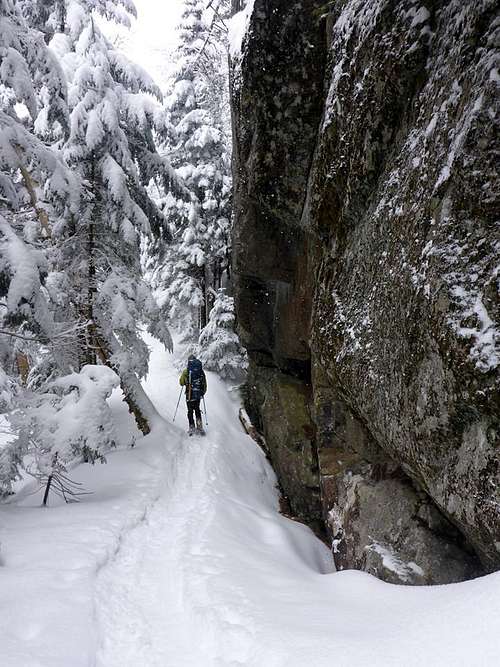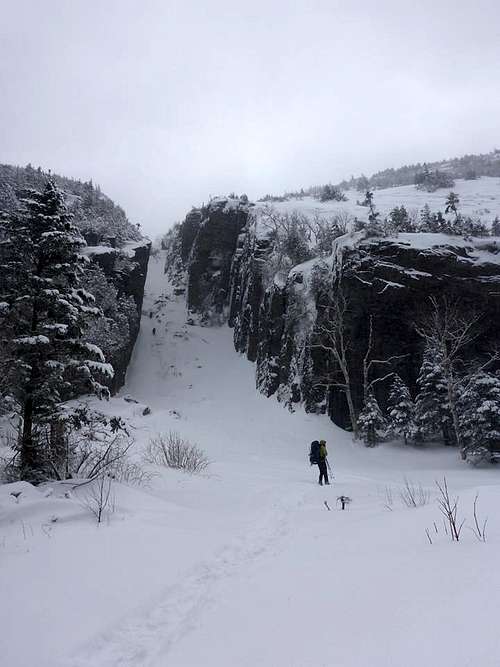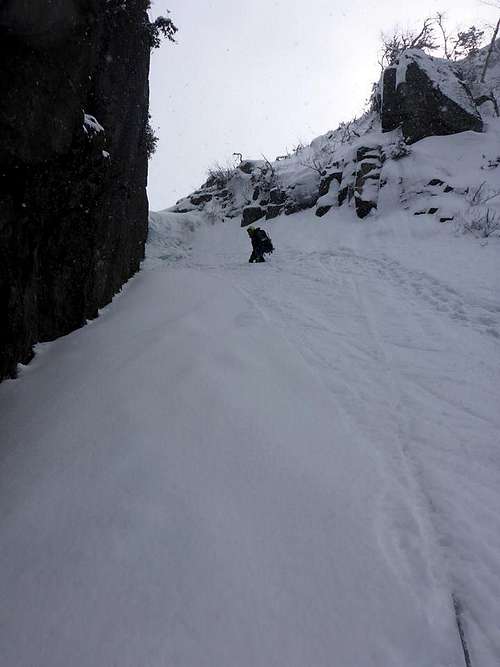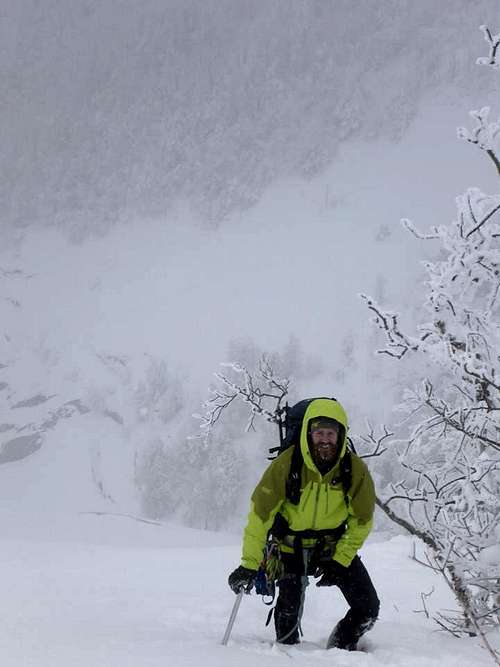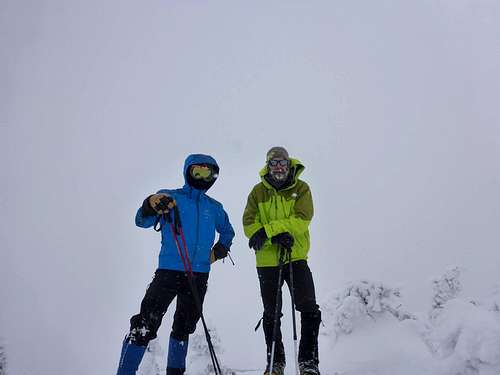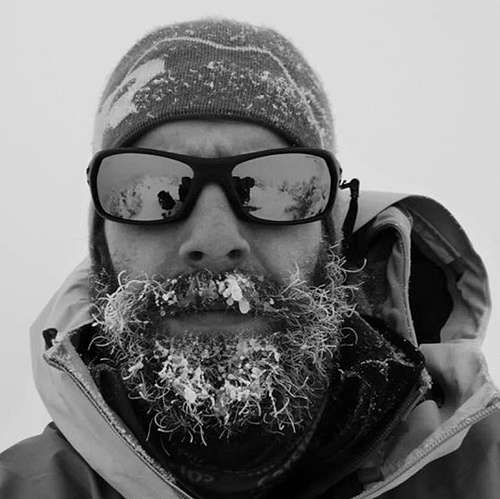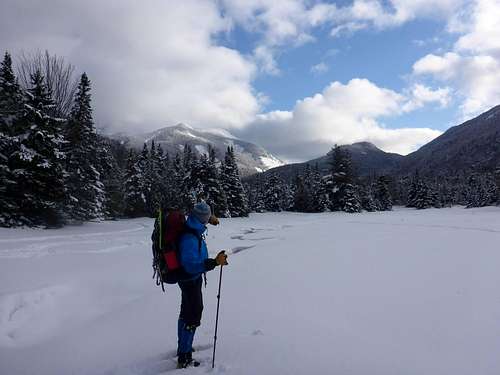Mixed Bag : A Winter Ascent of Mount Colden's Trap Dike
I had climbed the Trap dike during the summer months, told my climbing partner, Pierre-Philippe, about my experience and he convinced me to give it a shot in winter. Now, to the regular ice climber, the Trap Dike is probably not that big of a deal but I, as a hiker who had ice climbed a hand full of times in my life before this moment, was a little uncertain about our abilities to pull this off safely. We headed down to the Adirondack's on Friday night and arrived at the ACC hut in Keene where we spent the night. The next morning, we woke up at 6:30am, had a short breakfast and drove to the Adirondack loj where it took us a while to get going. We finally started walking at 8:30 and made our way to Avalanche lake. The trail was well pack since it was late in the winter season and no real accumulation of snow had fallen in the last week. We moved at a decent pace only stopping for a break slightly past Marcy dam. We finally got to the bottom of the dike at around 10:30 and even though the temperature only hovered in the low 20's, the wind made it brutally cold and I was happy to enter the dike where the wind was almost un-noticeable.
![On our way to avalanche lake]() On our way to avalanche lake
On our way to avalanche lake![Entering the Dike]() Entering the Dike
Entering the DikeThere was an other group of two about an hour ahead of us but by the time we put away the poles and snowshoes and put on our gear (harness, helmet, crampons, rope, climbing hardware and ice axes) they were out of sight. We had the dike basically to ourselves. Once all geared up we walk up to the first ice climb of the dike, a 10 foot frozen water fall. We set up a belay anchor at the bottom of the fall and Pierre-Philippe led the way up it before setting an anchor at the top for me to follow up. There wasn't a real need to put in intermediate protection so we didn't put anything other then for the two anchors. Once up this first water fall it's about a 100 foot ascent to the base of the next ice climb. This second water fall was about 15 feet high so I decided to put in an anchor at about the mid-point before finally toping out of the water fall and belaying my partner up.
![On our way to the second climb]() On our way to the second climb
On our way to the second climb From here, it's a long slog to the top of the dike/ base of the slide. It's was especially hard at this time in the season since the snow was deep and post-holing was inevitable. We took a well deserved break at the top of the dike just over the remains of a small avalanche triggered not to long before we got there (either triggered by the group in front of us or the group before them). After our break, we headed to the base of the slide which to me was the most difficult part. There was no real ice and the snow wasn't very deep. I was scratching the rock through the snow trying to find a either a bit of ice or a crack in the rock to grip with my ice tools and crampons. This transition between the dike and the slide was about 50-60 feet long but a slip would have probably only meant ripped clothing and a slide down 60 feet to the top of the dike possibly a broken bone. Clearly not the best case scenario but definitely not a life threatening scenario. Once I gingerly got to the base of the slide, where I could relax and stand in solid snow, I set up an anchor around a couple trees and belayed my partner up to where I was standing. From here to the top it was about an hour and a half to the top of mount Colden. The travel was slow due to the deep snow but thankfully, the groups in front of use broke a path for use and the post-holing was at a minimum. Once at the top of Colden, we un-roped. I was surprised to see that the summit, which usually has tree tall enough to block a good view (at the true summit, lots of views everywhere else on Colden), had only 6 inch tall tree top sticking up everywhere. There was about 6 or 7 feet of snow on the summit. We took a couple pictures and started heading back down via the trail to lake Arnold. From the summit, the trail was initially hard to find due to the blowing snow which had hidden away most tracks of anyone else being there before use. We took a few wrong turned which we had to double back on. It took use about 30 minutes to get back below the tree line to a trail which was easy to follow.
![Coming up the slide]() Coming up the slide
Coming up the slide![On the summit (great view)]() On the summit (great view)
On the summit (great view)![My awesome beard on the summit]() My awesome beard on the summit
My awesome beard on the summit
Once there, we took a long break out of the wind to refuel. It took us about 2 hours to get back to Marcy dam. Once there, noticed to skies were starting to clear, just in time for the end of our hike. After a break a Marcy dam enjoying the cloudy sky which was slowing turning blue, we pushed on to the loj and got to the registry at 6:30. A ten hour round trip in deep snow and a few lost trails, I thought we did pretty good time for people with little ice climbing experience. By the time we got back to the car, the sky was all cleared up except for a couple of little puff clouds. Driving back to the hut, we stopped of the side of the road for a few pictures of the high peaks which where almost all cleared up and offered us a great view. We drove back to Ottawa on Sunday morning after breakfast.
On Monday afternoon, I get a phone call from an Adirondack forest ranger asking me if I knew anything about two avalanches triggered on Saturday in the Trap dike. I was surprised to hear not one (the one we saw) but two avalanches had been triggered. We determined that the second one (which was bigger then the one we saw, and berried the two caught in it to the chest) was triggered by the group behind use. The Trap dike was all I imagined in winter, hiking, ice climbing and mountaineering/ rope travel, with its own dangers of avalanches, blowing snow and fatal falls. It's a real mixed bag of many different aspects of mountain climbing that not many people get the chance to bundle together in one day.
![Back at Marcy Dam]() Back at Marcy Dam
Back at Marcy Dam
Comments
No comments posted yet.


